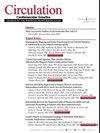我们对人类生殖系基因组编辑的真正看法是什么?它对医学意味着什么?
引用次数: 13
摘要
本文章由计算机程序翻译,如有差异,请以英文原文为准。
What Do We Really Think About Human Germline Genome Editing, and What Does It Mean for Medicine?
Genome editing has captured widespread attention because of its potential therapeutic applications. Early studies with human embryos have established the feasibility of human germline genome editing but raise complex social, ethical, and legal questions. In light of the potential impact of genome editing on the practice of cardiovascular medicine, we surveyed ≈300 attendees at a recent American Heart Association conference to elicit their opinions on somatic and germline genome editing. The results were revealing and highlight the need to broadly engage the public and solicit the opinions of various constituencies before proceeding with clinical germline genome editing.
Genome editing with clustered regularly interspaced short palindromic repeats/clustered regularly interspaced short palindromic repeat–associated 9 (CRISPR/Cas9) has proven so effective in vitro and in vivo that human therapeutic applications are already under pursuit. Clinical trials for somatic genome-editing therapies, that is, modification of cells, tissues, and organs in living people, have been announced in the United States and China. The first reports of human germline genome editing (GGE), that is, embryo modification, were published in 2015 and 2016, although those studies used nonviable embryos and relatively crude first-generation CRISPR/Cas9 tools. A more recent report in August 2017 of GGE to correct a disease-causing gene mutation in viable human embryos that, in principle, could have been carried to term and resulted in healthy offspring was widely heralded in the press as a breakthrough and drew considerable attention.1 What was particularly notable about this study was that the correction of the mutation was efficient and specific—unlike the earlier studies, unintended mutations were not observed elsewhere in the genome (off-target effects) in edited embryos, and mosaicism (mutations present in some cells in the embryo but not in …
求助全文
通过发布文献求助,成功后即可免费获取论文全文。
去求助
来源期刊

Circulation: Cardiovascular Genetics
CARDIAC & CARDIOVASCULAR SYSTEMS-GENETICS & HEREDITY
自引率
0.00%
发文量
0
审稿时长
6-12 weeks
期刊介绍:
Circulation: Genomic and Precision Medicine considers all types of original research articles, including studies conducted in human subjects, laboratory animals, in vitro, and in silico. Articles may include investigations of: clinical genetics as applied to the diagnosis and management of monogenic or oligogenic cardiovascular disorders; the molecular basis of complex cardiovascular disorders, including genome-wide association studies, exome and genome sequencing-based association studies, coding variant association studies, genetic linkage studies, epigenomics, transcriptomics, proteomics, metabolomics, and metagenomics; integration of electronic health record data or patient-generated data with any of the aforementioned approaches, including phenome-wide association studies, or with environmental or lifestyle factors; pharmacogenomics; regulation of gene expression; gene therapy and therapeutic genomic editing; systems biology approaches to the diagnosis and management of cardiovascular disorders; novel methods to perform any of the aforementioned studies; and novel applications of precision medicine. Above all, we seek studies with relevance to human cardiovascular biology and disease.
 求助内容:
求助内容: 应助结果提醒方式:
应助结果提醒方式:


